Translate this page into:
Turmeric: A condiment, cosmetic and cure
Correspondence Address:
Hima Gopinath
Department of Dermatology, Venereology and Leprosy, Sri Manakula Vinayagar Medical College and Hospital, Madagadipet, Puducherry - 605 107
India
| How to cite this article: Gopinath H, Karthikeyan K. Turmeric: A condiment, cosmetic and cure. Indian J Dermatol Venereol Leprol 2018;84:16-21 |
Abstract
Turmeric (Curcuma longa L.) is an integral part of Asian culture and cuisine. It has been used in traditional medicine since centuries. A myriad of health benefits have been attributed to it. Curcumin, the most biologically active curcuminoid in turmeric, is being investigated in pre-clinical and clinical trials for its role in disease prevention and cure. It has antioxidant, anti-inflammatory, antineoplastic, anti-proliferative and antimicrobial effects. We review the chemistry of this plant, its cultural relevance in Indian skin care, and its uses in dermatology.Introduction
Medicinal plants have been used since ancient time, and are sources of important modern drugs.[1] Turmeric (Curcuma longa L.)is a widely used condiment and colouring agent. India is the largest producer, exporter and consumer of turmeric, with a production of 8.46 lakh tonnes in the year 2014–2015.[2],[3] The name is derived from the Latin word “terra merita”, which means meritorious earth. It is also known as the “yellow root,” “golden spice,” “Indian saffron”, and has been used for at least 6000 years in traditional medicine and religious practice. It has 55 synonyms in Sanskrit based on its religious or medicinal properties.[4] The oldest reference to turmeric was in the Atharvaveda.[4] Marco Polo mentioned turmeric in his travel to India and China. Arab merchants introduced turmeric from India to the European markets in the 13th century.[5]
The Plant and Its Chemistry
Curcuma longa L. is a perennial rhizomatous herb which grows up to one metre in height [Figure - 1]. It is the most utilized species of the genus Curcuma and family Zingiberaceae. There are approximately 100 species in the genus, of which around 40 are of Indian origin.[6],[7] The Latin word “Curcuma” is derived from the Arabic word “Kourkoum”, which means saffron. It grows in hot, humid conditions and requires plenty of water. It has a short pseudostem and large oblong leaves. The underground rhizome has a primary or mother rhizome, with multiple branching secondary rhizomes. They are ovate, oblong, or pyriform and have a pale yellow, reddish yellow, or orange brown colour [Figure - 2]. It has pale yellow flowers and does not bear fruits. It is cultivated in India, China, Indonesia, Thailand, and other tropical regions including Africa.[2],[6],[8] “Madras” and “Alleppey” turmeric are the two main commercial types of turmeric in India, based on the area of production. Alleppey turmeric is imported by the United States as a food colourant and spice, whereas the British and Middle Eastern markets prefer Madras turmeric which has lower curcumin and volatile oils. Madras turmeric has a brighter lighter yellow colour that is suitable for mustard paste and curry powder/paste. The “Bengal” type is predominantly used as a dye.[9]
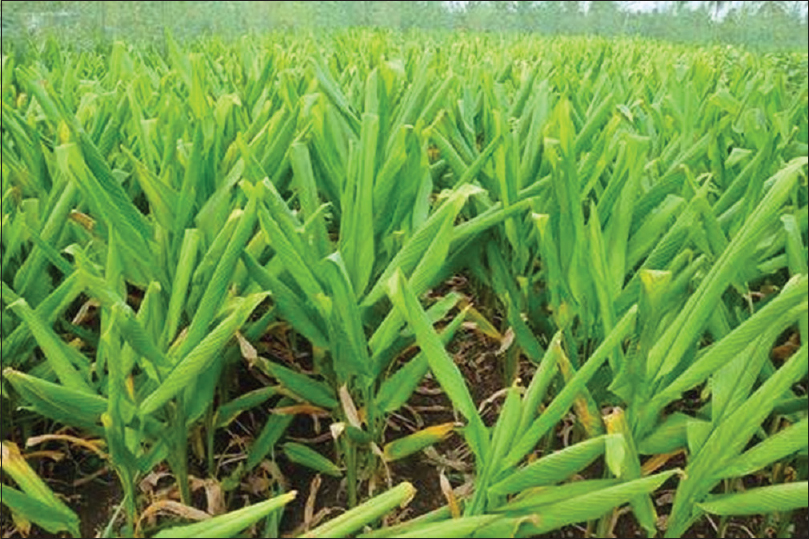 |
| Figure 1: Curcuma longa.L - a perennial medicinal herb |
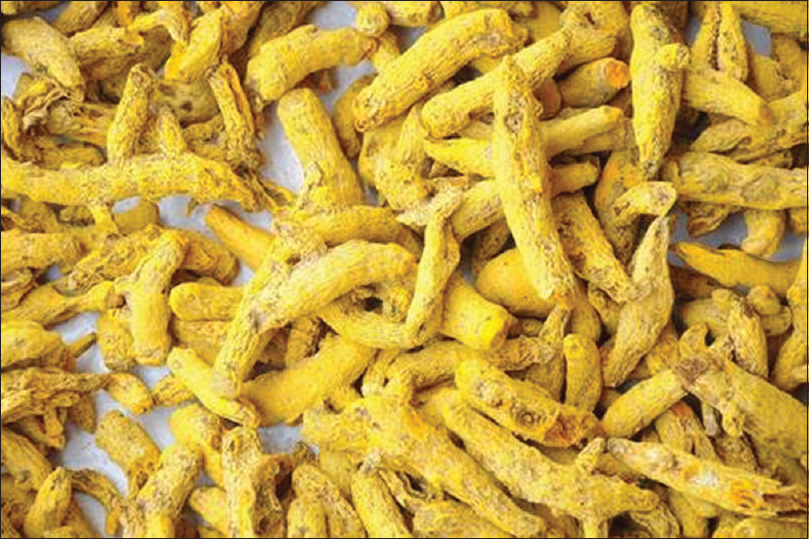 |
| Figure 2: Rhizomes of Curcuma longa.L |
The composition of the rhizome is summarized in [Table - 1].[2],[6],[10],[11] Curcuminoids give yellow colour while the oils provide the aromatic smell and taste.[6] Oils are used in aromatherapy and perfumes.[5] The essential oils may have antioxidant, anti-inflammatory and anti-nociceptive properties.[11] Curcumin is abundant in Curcuma longa but may also be obtained from other plant species such as Curcuma aromatica and Curcuma phaeocaulis. Pure turmeric has the highest curcumin concentration (average 3.14% by weight), whereas curry powders have relatively smaller concentrations.[12]
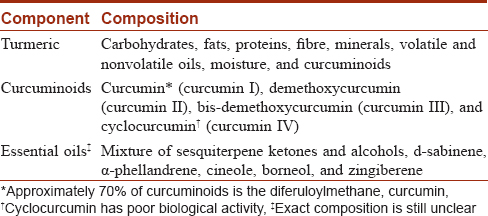
Curcumin
Curcumin was first isolated as “yellow colouring matter” from Curcuma longa by Vogel and Pelletier in 1815.[13] The structure, a diferuloylmethane, was elucidated by Lampe and Milobedeska in 1910. It exists as keto-enol tautomers. The keto form is predominant in neutral and acidic conditions, whereas the enol form predominates in alkaline conditions. It is insoluble in water, acidic and neutral pH; and soluble in methanol, ethanol, dimethylsulphoxide and acetone.[2],[10] It has the properties of an acid-base indicator as it is protonated and red at pH below one, neutral and bright yellow at pH 1–7, and de-protonated with red colour at pH more than 7.[5]
Variable degradation has been reported in alkaline medium. Photodegradation has also been reported. It is lipophilic and quickly passes through the cell membrane. In humans and rats, the intestinal metabolism involves both conjugation and reduction, yielding curcumin glucuronide, curcumin sulphate, tetrahydrocurcumin and hexahydrocurcumin. In-vitro degradation products of curcumin, dihydroferulic acid and ferulic acid were also noticed in-vivo in rats, and may have biological effects.[12] It is poorly absorbed, rapidly metabolized in the liver, and eliminated via the gall bladder. There is minimal excretion in urine.[5]
The clinical efficacy of oral curcumin may be lower than in-vitro studies due to poor bioavailability and extensive first pass metabolism. The therapeutic potential of curcumin in-vitro has been reported at concentrations in the micromolar range, whereas the plasma concentration after oral intake is in the nanomolar range.[14] Newer technologies such as adjuvants, nanoparticles, liposomes, micelles and phospholipid complexes are being evaluated to increase the oral bioavailability of curcumin.[10] Studies often do not mention the exact content of curcumin used, and it is variable in commercial preparations. In addition, it exists in different forms with different biological potencies.[12]
Biological effects of curcumin
Curcumin is a highy pleiotropic molecule that influences multiple signalling pathways. It has anti-inflammatory, anti-oxidant, antimicrobial, hypoglycemic, wound healing, chemopreventive, chemosensitising and radiosensitising properties.[15] The various targets of curcumin are summarised in [Table - 2].[15],[16],[17],[18] The functional consequences of these interactions need further investigation.

Traditional uses
Species such as C. longa, C. aromatica, C. caesia, C. zedoaria, C. kwangsiensis, C. phaeocaulis and C. comosa have been used in used in Ayurveda, Siddha, Unani, Chinese, veterinary, and folk medicine throughout South-East Asia. It is a common household remedy for many ailments such as cough, respiratory ailments, anorexia, rheumatism, dysentery, abdominal pain and dental disorders. Gastrointestinal disorders such as liver disease, acidity, dyspepsia, ulcers, indigestion, and flatulence are also treated. A hot poultice made from turmeric and slaked lime is used to relieve muscle pain and inflammation caused by injury. Fresh turmeric is applied to perineal laceration after delivery to aid wound healing. It is applied to the severed umbilical cord of new-borns in rural India as an antiseptic. Women are given warm milk with turmeric, ginger and honey to drink after childbirth. Turmeric paste is applied for various skin diseases, burns, bites and eye infections. Turmeric and neem have been used for the treatment of small pox and chicken pox.[2],[4],[7],[12],[13]
Turmeric has been used in traditional occasions from birth to burial. It is considered to be sacred, auspicious and a harbinger of prosperity. A piece of turmeric tied to a turmeric dyed thread is used as the nuptial string in many Indian communities [Figure - 3]. It is applied to the entire body of the bride and bridegroom on the previous day of marriage. Clothes dyed or marked with it are considered auspicious. It is applied on the forehead, cheeks, and neck [Figure 4a] and [Figure 4b] on auspicious occasions, as well as every evening in some communities. Women have been described as attractive in classic Indian literature if their face and bodies are shining yellow. It is used in Hindu temple practices and rituals such as “Homa” and “Pooja”, and as an amulet to ward off evil spirits.[4],[19] “Kumkum” was traditionally prepared by alkalinizing turmeric powder. It is applied by married women on the parting of the hairline or on the centre of the forehead. Commercial forms are now available but the composition is not clear. It contains starch, chalk powder, azo or other dyes, fragrance, turmeric, groundnut oil, tragacanth gum, parabens and canaga oil.[20],[21]
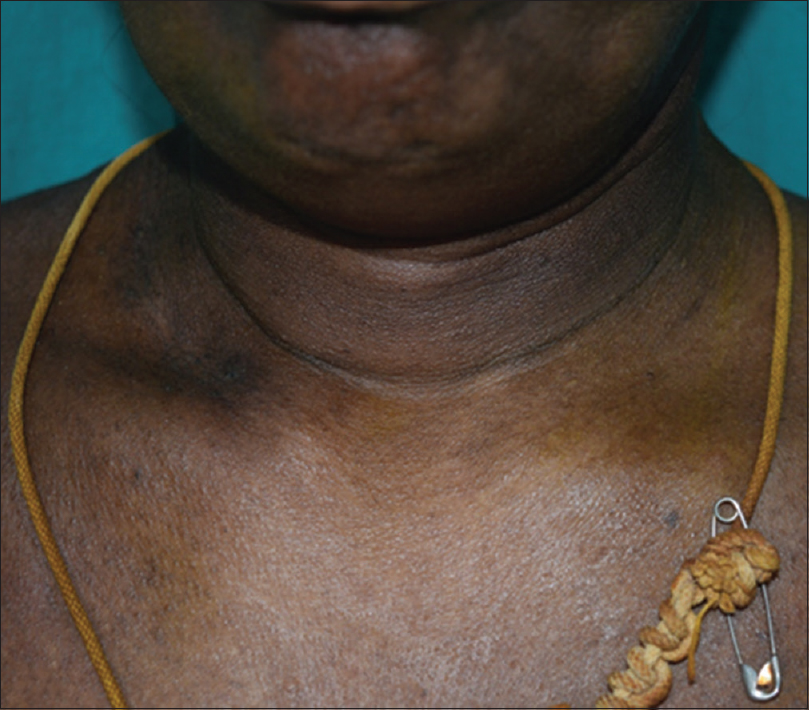 |
| Figure 3: Thread dyed with turmeric is used as nuptial string (“thaali”) |
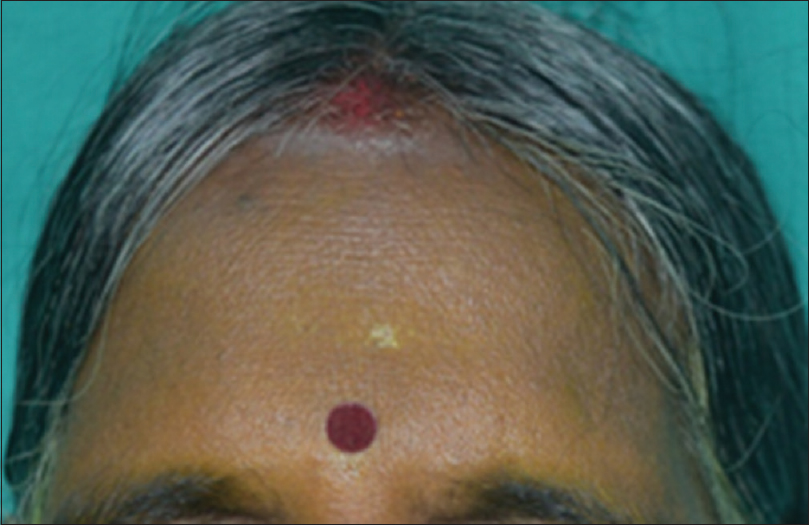 |
| Figure 4a: Traditional application of turmeric and kumkum |
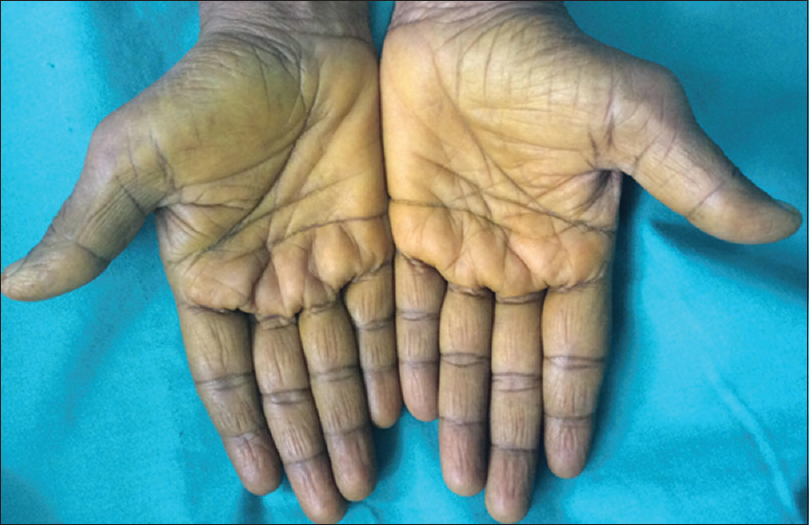 |
| Figure 4b: Yellowish discolouration of hands after application of turmeric |
Condiment
Turmeric is used in cooking for its aroma and colour. Up to 1.5 g is consumed per day in South East Asian communities. The flavour, colour and preservative properties have increased its global appeal.[22] It is a component of curry powder (10–30% turmeric) used to flavour meat and fish. Vegetarian curry mixes have lower turmeric content due to the bitter taste. Turmeric oleoresins obtained from solvent extraction of the powdered rhizomes are used in the food industry for its colour and pungent, bitter taste.[9]
Colouring agent
The yellow colour of curcumin has been utilized in the food, textile and cosmetic industry. It is used as a food additive.[2] As it is similar in colour to the synthetic tartrazine, it is a natural alternative. It has been used to colour mustard, dairy products, pastries, soups, sauces, gravies, fish and cereals. However, it can be used only for certain foodstuffs and is for short-term storage. This is due to its light sensitivity and degradation on exposure to heat, chemical oxidants, and alkaline conditions. The Joint FAO/WHO Expert Committee on Food Additives has set the acceptable daily intake of curcumin to 0–3 mg/kg/day.[5],[9]
Cosmetology
Turmeric may be the first known cosmetic as it has been traditionally smeared on the skin by women.[4] It is believed to reduce facial hair growth, reduce acne and improve complexion.[4],[23] Many women in Tamil Nadu still apply turmeric on their face daily before taking bath (authors' observation). The yellow colour has been utilized in skin care products. Tetrahydrocurcumin is an off-white hydrogenated form of curcumin that is used topically as a cutaneous antioxidant. It may prevent rancidity of lipids when added to moisturizers.[24] Curcuminoids have potential in cosmeceuticals as antioxidant, anti-inflammatory and skin lightening agents. In-vitro curcuminoids inhibit collagenase, elastase and hyaluronidase.[25] Curcumin gel has been reported to improve the appearance of photodamaged skin conditions such as pigmentary changes, solar elastoses, actinic poikiloderma, solar lentigines and actinic keratosis when applied for prolonged period such as six months. It may promote apoptosis of cells with DNA damage.[26] It is being evaluated as an environmental friendly hair colouring agent.[27] The essential oils may have potential in the perfume, cosmetic and soap industry.[7]
Dermatological uses
Curcumin has potential in inflammatory and neoplastic disorders of the skin. High-dose curcuminoids at a dose of 6 g per day improved the signs and symptoms of oral lichen planus in a randomized double blind placebo controlled trial of 20 patients. It was well tolerated, with diarrhoea being the most common adverse effect.[28] Curcumin inhibited crucial psoriasis pathways such as NF-kβ and downstream inflammation including Th1 cytokines in animal and in-vitro studies. However, a small open-labelled study in patients with moderate to severe psoriasis showed low efficacy of oral curcumin, which may be due to its reduced oral availability.[29] Topical gel preparation of 1% curcumin inhibited phosphorylase kinase and improved the lesions in chronic plaque psoriasis.[30] It may also promote healing and prevent scarring in acute injuries such as burns, by inhibiting phosphorylase kinase and subsequent NF-kB/TGF-β signalling pathway.[26]
Curcumin causes upregulation of p53 and apoptosis of human basal cell carcinoma cells. It also inhibits NF-kB and induces apoptosis in mouse and human melanoma cells.[31],[32],[33] A combination of low dose curcumin with red united blue light irradiation caused oxidative stress mediated cell death, inhibited proliferation and enhanced apoptosis of human melanoma cells.[34] It also suppresses the growth and proliferation of squamous cell carcinoma by inhibition of NF-kβ.[35] Topical application may have an inhibitory effect on chemical carcinogenesis of the skin.[22] It has an inhibitory effect on cutaneous T cell lymphoma as it induces selective apoptosis in cutaneous T cell lymphoma cell lines by downregulating STAT-3 and NF-kβ pathways.[36]
Curcumin accelerated wound healing in rats is attributed to its antioxidant properties. It inhibits cyclo-oxygenase 2, lipo-oxygenase and the release of inflammatory cytokines from macrophages and monocytes. It increases granulation tissue, neovascularization and enhances synthesis of extracellular matrix components including collagen.[37] Curcumin may have potential in scleroderma as it causes selective apoptosis of disease affected lung fibroblasts. This may be due to low protein kinase Cε, producing lower levels of glutathione-S-tranferase in the lung fibroblasts of scleroderma patients.[38] A combination of topical tetrahydrocurcumin and targeted narrowband UVB phototherapy produced better repigmentation than UVB alone, but the difference was not statistically significant.[39] Curcumin may be a promising antifungal against Candida.[40] It may also have potential as an antimicrobial, antiparasitic and antiviral agent.[41]
Adverse effects
Curcumin at a dose of less than 100 mg/day has been a part of diet in certain countries for centuries.[31] Acute toxicity to oral curcumin is unlikely due to poor bioavailability, and is well tolerated for short-term use at a dose of up to 8 g per day. Nausea, diarrhoea and dyspepsia have been reported. It is contraindicated in obstructive disorders of the biliary tract, gallstones and hypersensitivity. It was neither mutagenic in-vitro, nor teratogenic in rats or mice. Safety in pregnancy, lactation and children is not established with clinical data.[8] Long-term safety as a compounded medicine is not clear due to factors such as variation in products and doses used in trials, possible drug interactions, poor bioavailability, exposure to impurities, limited studies and uncertain evidence of carcinogenicity in animal studies. Lower cellular levels of curcumin have an antioxidant role, but higher levels may lead to increased reactive oxygen species (ROS).[14] It has been implicated as a contributing factor to oxidative stress in acute vitiligo.[42] It has been reported to inhibit apoptosis caused by cytotoxic chemotherapeutic agents in breast cancer.[43] Its potential antiplatelet effects may merit its discontinuation prior to cutaneous surgery.[44]
Contact urticaria (both immunologic and non-immunologic) has been reported with topical curcumin.[45] Allergic contact dermatitis to turmeric or curcumin with positive patch tests has been reported in varied settings. It has also been reported with tetrahydrocurcumin which was used as an antioxidant in sunscreen.[46] Kumkum can cause allergic and pigmented contact dermatitis though the allergens are variable.[21] We have observed allergic and pigmented contact dermatitis with turmeric [Figure - 5].
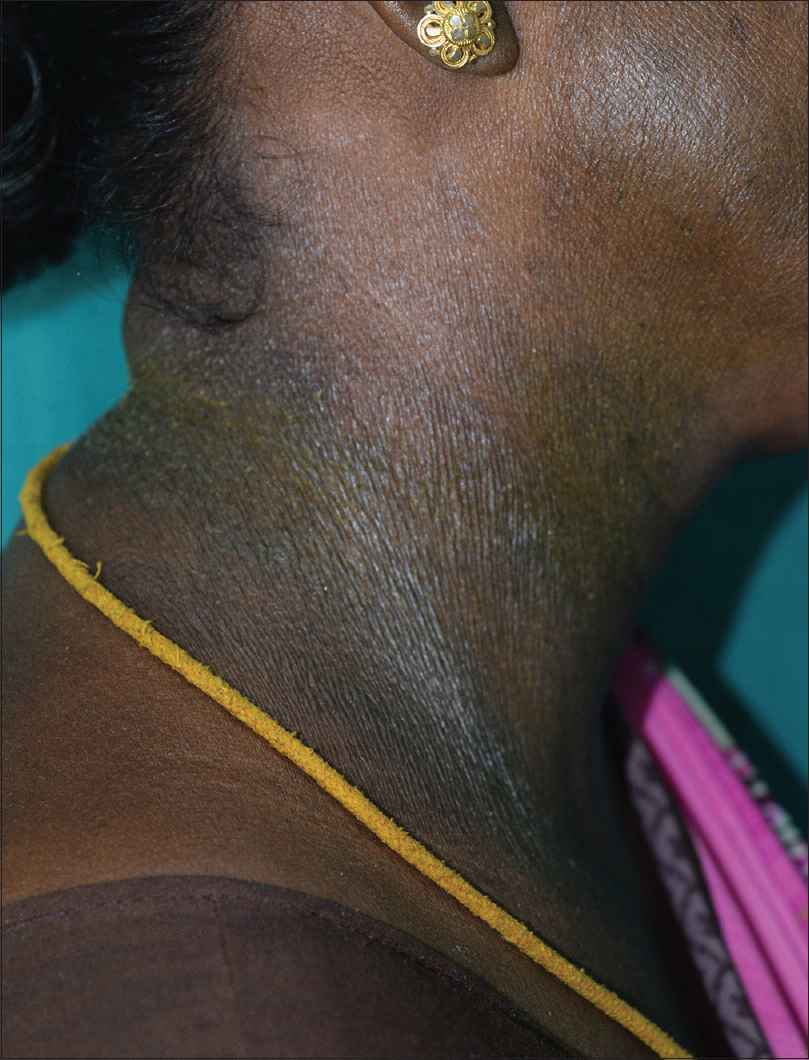 |
| Figure 5: Pigmented contact dermatitis over face and neck after traditional application of turmeric on face, neck and thali. |
Conclusion
The “yellow root”, turmeric, is deeply rooted in many cultures. An increased awareness regarding its traditional uses, benefits, adverse effects, and more studies with better bioavailable formulations is needed. This age-old spice will slowly find its way into the dermatology armamentarium of the future.
Declaration of patient consent
The authors certify that they have obtained all appropriate patient consent forms. In the form the patient(s) has/have given his/her/their consent for his/her/their images and other clinical information to be reported in the journal. The patients understand that their names and initials will not be published and due efforts will be made to conceal their identity, but anonymity cannot be guaranteed.
Financial support and sponsorship
Nil.
Conflicts of interest
There are no conflicts of interest.
| 1. |
Gurib-Fakim A. Medicinal plants: Traditions of yesterday and drugs of tomorrow. Mol Aspects Med 2006;27:1-93.
[Google Scholar]
|
| 2. |
Trujillo J, Chirino YI, Molina-Jijón E, Andérica-Romero AC, Tapia E, Pedraza-Chaverrí J. Renoprotective effect of the antioxidant curcumin: Recent findings. Redox Biol 2013;1:448-56.
[Google Scholar]
|
| 3. |
2016. Available from: http://www.indianspices.com/html/s0420sts.html. [Last accessed on 2016 Oct 20].
[Google Scholar]
|
| 4. |
Ravindran P, Nirmal Babu K, Sivaraman K. Turmeric. Boca Raton, FL: CRC Press; 2007.
[Google Scholar]
|
| 5. |
Esatbeyoglu T, Huebbe P, Ernst IM, Chin D, Wagner AE, Rimbach G. Curcumin – From molecule to biological function. Angew Chem Int Ed Engl 2012;51:5308-32.
[Google Scholar]
|
| 6. |
Parthasarathy V, Chempakam B, Zachariah T. Chemistry of Spices. Wallingford, UK: CABI Pub.; 2008.
[Google Scholar]
|
| 7. |
Sasikumar B. Genetic resources of Curcuma: Diversity, characterization and utilization. Plant Genet Resour 2005;3:230-51.
[Google Scholar]
|
| 8. |
WHO Monographs on Selected Medicinal Plants-Volume 1: Rhizoma Curcumae Longae. Apps.who.int. 2016. Available from: http://www.apps.who.int/medicinedocs/en/d/Js2200e/14.html. [Last accessed on 2016 Oct 20].
[Google Scholar]
|
| 9. |
2016. Available from: http://www.fao.org/fileadmin/user_upload/inpho/docs/Post_Harvest_Compendium_-_Turmeric.pdf. [Last accessed on 2016 Oct 20].
[Google Scholar]
|
| 10. |
Prasad S, Gupta SC, Tyagi AK, Aggarwal BB. Curcumin, a component of golden spice: From bedside to bench and back. Biotechnol Adv 2014;32:1053-64.
[Google Scholar]
|
| 11. |
Liju VB, Jeena K, Kuttan R. An evaluation of antioxidant, anti-inflammatory, and antinociceptive activities of essential oil from Curcuma longa. L. Indian J Pharmacol 2011;43:526-31.
[Google Scholar]
|
| 12. |
Hatcher H, Planalp R, Cho J, Torti FM, Torti SV. Curcumin: From ancient medicine to current clinical trials. Cell Mol Life Sci 2008;65:1631-52.
[Google Scholar]
|
| 13. |
Bandyopadhyay D. Farmer to pharmacist: Curcumin as an anti-invasive and antimetastatic agent for the treatment of cancer. Front Chem 2014;2:113.
[Google Scholar]
|
| 14. |
Burgos-Morón E, Calderón-Montaño JM, Salvador J, Robles A, López-Lázaro M. The dark side of curcumin. Int J Cancer 2010;126:1771-5.
[Google Scholar]
|
| 15. |
Gupta SC, Prasad S, Kim JH, Patchva S, Webb LJ, Priyadarsini IK, et al. Multitargeting by curcumin as revealed by molecular interaction studies. Nat Prod Rep 2011;28:1937-55.
[Google Scholar]
|
| 16. |
Goel A, Kunnumakkara AB, Aggarwal BB. Curcumin as “Curecumin”: From kitchen to clinic. Biochem Pharmacol 2008;75:787-809.
[Google Scholar]
|
| 17. |
Kunnumakkara AB, Anand P, Aggarwal BB. Curcumin inhibits proliferation, invasion, angiogenesis and metastasis of different cancers through interaction with multiple cell signaling proteins. Cancer Lett 2008;269:199-225.
[Google Scholar]
|
| 18. |
Gupta SC, Patchva S, Koh W, Aggarwal BB. Discovery of curcumin, a component of golden spice, and its miraculous biological activities. Clin Exp Pharmacol Physiol 201;39:283-99.
[Google Scholar]
|
| 19. |
Sopher DE. Indigenous uses of turmeric (C. domestica) in Asia and Oceania. Anthropos 1964;59:93-127.
[Google Scholar]
|
| 20. |
Gupta D, Thappa DM. Dermatoses due to Indian cultural practices. Indian J Dermatol 2015;60:3-12.
[Google Scholar]
|
| 21. |
Chaudhari SP, Tam AY, Barr JA. Curcumin: A contact allergen. J Clin Aesthet Dermatol 2015;8:43-8.
[Google Scholar]
|
| 22. |
Sharma RA, Gescher AJ, Steward WP. Curcumin: The story so far. Eur J Cancer 2005;41:1955-68.
[Google Scholar]
|
| 23. |
Shaffrathul JH, Karthick PS, Rai R, Srinivas CR. Turmeric: Role in hypertrichosis and acne. Indian J Dermatol 2007;52:116.
[Google Scholar]
|
| 24. |
Draelos ZD. Nutrition and enhancing youthful-appearing skin. Clin Dermatol 2010;28:400-8.
[Google Scholar]
|
| 25. |
Koo E, Kimbal AB, Wanner M. Cosmeceuticals. In: Griffiths C, Barker J, Bleiker T, Chalmers R, Creamer D, editors. Rook's Textbook of Dermatology. 9th ed. Oxford, UK: John Wiley & Sons; 2016. p. 156.6.
[Google Scholar]
|
| 26. |
Heng MC. Curcumin targeted signaling pathways: Basis for anti-photoaging and anti-carcinogenic therapy. Int J Dermatol 2010;49:608-22.
[Google Scholar]
|
| 27. |
Boga C, Delpivo C, Ballarin B, Morigi M, Galli S, Micheletti G, et al. Investigation on the dyeing power of some organic natural compounds for a green approach to hair dyeing. Dye Pigment 2013;97:9-18.
[Google Scholar]
|
| 28. |
Chainani-Wu N, Madden E, Lozada-Nur F, Silverman S Jr. High-dose curcuminoids are efficacious in the reduction in symptoms and signs of oral lichen planus. J Am Acad Dermatol 2012;66:752-60.
[Google Scholar]
|
| 29. |
Kurd SK, Smith N, VanVoorhees A, Troxel AB, Badmaev V, Seykora JT, et al. Oral curcumin in the treatment of moderate to severe psoriasis vulgaris: A prospective clinical trial. J Am Acad Dermatol 2008;58:625-31.
[Google Scholar]
|
| 30. |
Heng MC, Song MK, Harker J, Heng MK. Drug-induced suppression of phosphorylase kinase activity correlates with resolution of psoriasis as assessed by clinical, histological and immunohistochemical parameters. Br J Dermatol 2000;143:937-49.
[Google Scholar]
|
| 31. |
Jee SH, Shen SC, Tseng CR, Chiu HC, Kuo ML. Curcumin induces a p53-dependent apoptosis in human basal cell carcinoma cells. J Invest Dermatol 1998;111:656-61.
[Google Scholar]
|
| 32. |
Marín YE, Wall BA, Wang S, Namkoong J, Martino JJ, Suh J, et al. Curcumin downregulates the constitutive activity of NF-kappaB and induces apoptosis in novel mouse melanoma cells. Melanoma Res 2007;17:274-83.
[Google Scholar]
|
| 33. |
Siwak DR, Shishodia S, Aggarwal BB, Kurzrock R. Curcumin-induced antiproliferative and proapoptotic effects in melanoma cells are associated with suppression of IkappaB kinase and nuclear factor kappaB activity and are independent of the B-Raf/mitogen-activated/extracellular signal-regulated protein kinase pathway and the Akt pathway. Cancer 2005;104:879-90.
[Google Scholar]
|
| 34. |
Niu T, Tian Y, Mei Z, Guo G. Inhibition of autophagy enhances curcumin united light irradiation-induced oxidative stress and tumor growth suppression in human melanoma cells. Sci Rep 2016;6:31383.
[Google Scholar]
|
| 35. |
Aggarwal S, Takada Y, Singh S, Myers JN, Aggarwal BB. Inhibition of growth and survival of human head and neck squamous cell carcinoma cells by curcumin via modulation of nuclear factor-kappaB signaling. Int J Cancer 2004;111:679-92.
[Google Scholar]
|
| 36. |
Zhang C, Li B, Zhang X, Hazarika P, Aggarwal BB, Duvic M. Curcumin selectively induces apoptosis in cutaneous T-cell lymphoma cell lines and patients' PBMCs: Potential role for STAT-3 and NF-kappaB signaling. J Invest Dermatol 2010;130:2110-9.
[Google Scholar]
|
| 37. |
Merrell JG, McLaughlin SW, Tie L, Laurencin CT, Chen AF, Nair LS. Curcumin-loaded poly(epsilon-caprolactone) nanofibres: Diabetic wound dressing with anti-oxidant and anti-inflammatory properties. Clin Exp Pharmacol Physiol 2009;36:1149-56.
[Google Scholar]
|
| 38. |
Duvoix A, Blasius R, Delhalle S, Schnekenburger M, Morceau F, Henry E, et al. Chemopreventive and therapeutic effects of curcumin. Cancer Lett 2005;223:181-90.
[Google Scholar]
|
| 39. |
Asawanonda P, Klahan SO. Tetrahydrocurcuminoid cream plus targeted narrowband UVB phototherapy for vitiligo: A preliminary randomized controlled study. Photomed Laser Surg 2010;28:679-84.
[Google Scholar]
|
| 40. |
Martins CV, da Silva DL, Neres AT, Magalhães TF, Watanabe GA, Modolo LV, et al. Curcumin as a promising antifungal of clinical interest. J Antimicrob Chemother 2009;63:337-9.
[Google Scholar]
|
| 41. |
Marathe SA, Dasgupta I, Gnanadhas DP, Chakravortty D. Multifaceted roles of curcumin: Two sides of a coin! Expert Opin Biol Ther 2011;11:1485-99.
[Google Scholar]
|
| 42. |
Schallreuter KU, Rokos H. Turmeric (curcumin): A widely used curry ingredient, can contribute to oxidative stress in Asian patients with acute vitiligo. Indian J Dermatol Venereol Leprol 2006;72:57-9.
[Google Scholar]
|
| 43. |
Somasundaram S, Edmund NA, Moore DT, Small GW, Shi YY, Orlowski RZ. Dietary curcumin inhibits chemotherapy-induced apoptosis in models of human breast cancer. Cancer Res 2002;62:3868-75.
[Google Scholar]
|
| 44. |
Brown DG, Wilkerson EC, Love WE. A review of traditional and novel oral anticoagulant and antiplatelet therapy for dermatologists and dermatologic surgeons. J Am Acad Dermatol 2015;72:524-34.
[Google Scholar]
|
| 45. |
Liddle M, Hull C, Liu C, Powell D. Contact urticaria from curcumin. Dermatitis 2006;17:196-7.
[Google Scholar]
|
| 46. |
Calapai G, Miroddi M, Minciullo PL, Caputi AP, Gangemi S, Schmidt RJ. Contact dermatitis as an adverse reaction to some topically used European herbal medicinal products-part 1: Achillea millefolium-Curcuma longa. Contact Dermatitis 2014;71:1-12.
[Google Scholar]
|
Fulltext Views
40,792
PDF downloads
7,851





